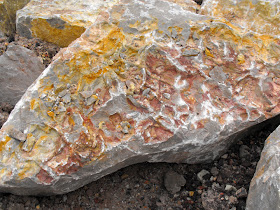The new QVC, like the 1958 one, will be a striking and unique building, both pleasing to look at and be in. However, another consideration is the building’s surroundings. The gull-wing roof mimics the cut that the quarry sits in and the hills surrounding it. While designed to fit the terrain, limited landscaping elements will be added to improve the overall look and feel of the site. Among those elements are a series of large blocks of rock. While larges pieces of blocks are not unusual landscaping fare, these blocks do hold some surprises.
The rocks came from a quarry near Maybell, CO. They are pieces of Paleozoic limestone, carbonate rich rock formed of sediments deposited on an ocean floor well before the Age of Dinosaurs. They are grey-beige-brown and match the color of the rocks in the area of the QVC.
However, closer inspection of the bedding surfaces of the blocks reveals some interesting features. These surfaces are quite irregular, showing a dense pattern of thick sinuous ridges that branch and intersect, separated by depressions. The causal observer might be forgiven for thinking they are ripple currents or infilled mudcracks, if the casual observer would even notice the texture at all.
But the ridges are actually ancient burrows made by marine arthropods living on a seafloor hundreds of millions of years ago. The scientific name for these burrows is Thallasinoides. They are common fossils in marine rocks worldwide. In modern day oceans Thalassinoides-like burrows are made primarily by decapods, especially thalassinid shrimp, in intertidal and shallow subtidal marine settings (1). However, Paleozoic crustacean fossils are rare and many Paleozoic Thalassinoides may have had other makers (2)
So when you come to visit the QVC after it reopens in October 2011, remember to take a look at the landscape rocks and their burrows when you are waiting for the shuttle bus. It may be the first time that you have seen this interesting kind of fossil, although they are nowhere near as interesting as the nearby quarry full of majestic dinosaur bones.
Thanks to Tony Ekdale (paleontologist, University of Utah) for identifying the burrows as Thalassinoides.
References
(1) Myrow, P. 1995. Thalassinoides and the enigma of Early Paleozoic open-framework burrow systems. Palaios 10: 58-74.(2) Ekdale, A.A. and R.G. Bromley 2003. Paleoethologic interpretation of complex Thalassinoides in shallow-marine limestones, Lower Ordovician, southern Sweden. Palaeogeography, Paleoclimatology, Palaeoecology 192: 221-227.











